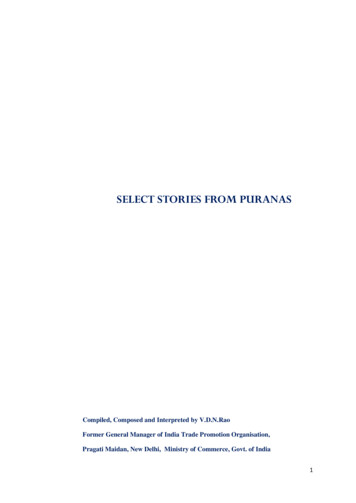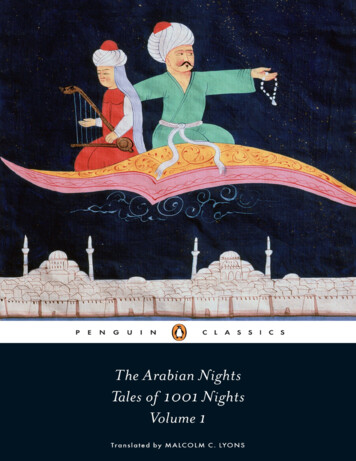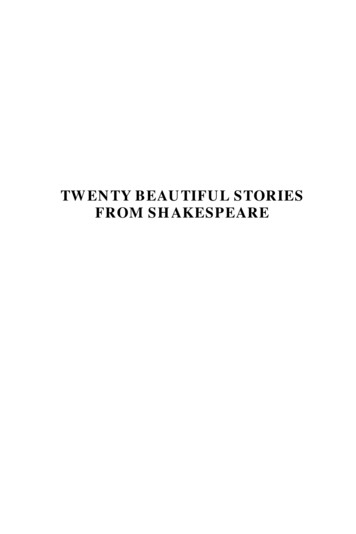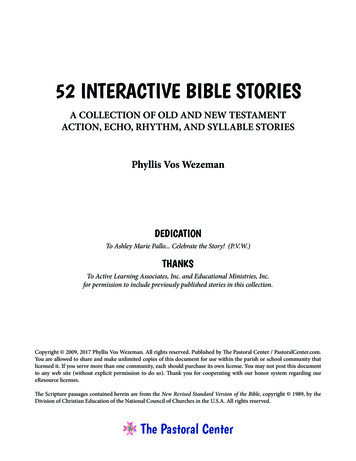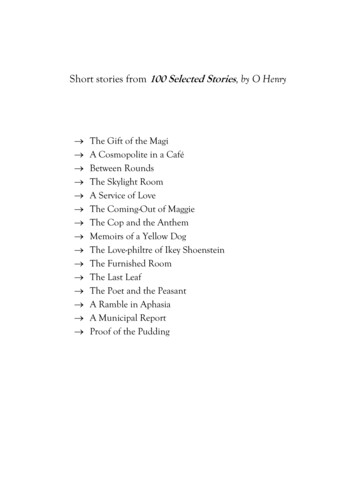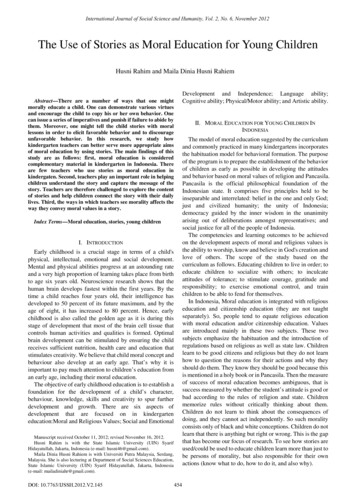
Transcription
International Journal of Social Science and Humanity, Vol. 2, No. 6, November 2012The Use of Stories as Moral Education for Young ChildrenHusni Rahim and Maila Dinia Husni RahiemDevelopment and Independence; Language ability;Cognitive ability; Physical/Motor ability; and Artistic ability.Abstract—There are a number of ways that one mightmorally educate a child. One can demonstrate various virtuesand encourage the child to copy his or her own behavior. Onecan issue a series of imperatives and punish if failure to abide bythem. Moreover, one might tell the child stories with morallessons in order to elicit favorable behavior and to discourageunfavorable behavior. In this research, we study howkindergarten teachers can better serve more appropriate aimsof moral education by using stories. The main findings of thisstudy are as follows: first, moral education is consideredcomplementary material in kindergarten in Indonesia. Thereare few teachers who use stories as moral education inkindergaten. Second, teachers play an important role in helpingchildren understand the story and capture the message of thestory. Teachers are therefore challenged to explore the contentof stories and help children connect the story with their dailylives. Third, the ways in which teachers see morality affects theway they convey moral values in a story.II. MORAL EDUCATION FOR YOUNG CHILDREN ININDONESIAThe model of moral education suggested by the curriculumand commonly practiced in many kindergartens incorporatesthe habituation model for behavioral formation. The purposeof the program is to prepare the establishment of the behaviorof children as early as possible in developing the attitudesand behavior based on moral values of religion and Pancasila.Pancasila is the official philosophical foundation of theIndonesian state. It comprises five principles held to beinseparable and interrelated: belief in the one and only God;just and civilized humanity; the unity of Indonesia;democracy guided by the inner wisdom in the unanimityarising out of deliberations amongst representatives; andsocial justice for all of the people of Indonesia.The competencies and learning outcomes to be achievedon the development aspects of moral and religious values isthe ability to worship, know and believe in God's creation andlove of others. The scope of the study based on thecurriculum as follows. Educating children to live in order; toeducate children to socialize with others; to inculcateattitudes of tolerance; to stimulate courage, gratitude andresponsibility; to exercise emotional control, and trainchildren to be able to fend for themselves.In Indonesia, Moral education is integrated with religiouseducation and citizenship education (they are not taughtseparately). So, people tend to equate religious educationwith moral education and/or citizenship education. Valuesare introduced mainly in these two subjects. These twosubjects emphasize the habituation and the introduction ofregulations based on religious as well as state law. Childrenlearn to be good citizens and religious but they do not learnhow to question the reasons for their actions and why theyshould do them. They know they should be good because thisis mentioned in a holy book or in Pancasila. Then the measureof success of moral education becomes ambiguous, that issuccess measured by whether the student’s attitude is good orbad according to the rules of religion and state. Childrenmemorize rules without critically thinking about them.Children do not learn to think about the consequences ofdoing, and they cannot act independently. So such moralityconsists only of black and white conceptions. Children do notlearn that there is anything but right or wrong. This is the gapthat has become our focus of research. To see how stories areused/could be used to educate children learn more than just tobe persons of morality, but also responsible for their ownactions (know what to do, how to do it, and also why).Index Terms—Moral education, stories, young childrenI. INTRODUCTIONEarly childhood is a crucial stage in terms of a child'sphysical, intellectual, emotional and social development.Mental and physical abilities progress at an astounding rateand a very high proportion of learning takes place from birthto age six years old. Neuroscience research shows that thehuman brain develops fastest within the first years. By thetime a child reaches four years old, their intelligence hasdeveloped to 50 percent of its future maximum, and by theage of eight, it has increased to 80 percent. Hence, earlychildhood is also called the golden age as it is during thisstage of development that most of the brain cell tissue thatcontrols human activities and qualities is formed. Optimalbrain development can be stimulated by ensuring the childreceives sufficient nutrition, health care and education thatstimulates creativity. We believe that child moral concept andbehaviour also develop at an early age. That’s why it isimportant to pay much attention to children’s education froman early age, including their moral education.The objective of early childhood education is to establish afoundation for the development of a child’s character,behaviour, knowledge, skills and creativity to spur furtherdevelopment and growth. There are six aspects ofdevelopment that are focused on in kindergarteneducation:Moral and Religious Values; Social and EmotionalManuscript received October 11, 2012; revised November 16, 2012.Husni Rahim is with the State Islamic University (UIN) SyarifHidayatullah, Jakarta, Indonesia (e-mail: husni46@gmail.com).Maila Dinia Husni Rahiem is with Universiti Putra Malaysia, Serdang,Malaysia. She is also lecturing at Department of Social Sciences Education,State Islamic University (UIN) Syarif Hidayatullah, Jakarta, Indonesia(e-mail: mailadiniahr@gmail.com).DOI: 10.7763/IJSSH.2012.V2.145454
International Journal of Social Science and Humanity, Vol. 2, No. 6, November 2012form of bedtime stories or reading aloud. Schools usestorytelling as a pedagogic tool. In kindergarten, stories andstorytelling are used for learning languages, especially inreading and writing. Stories are routinely read in theclassroom. Stories have the potential to function as a vehicleof moral education for young children. Children learn theirown religious, social and cultural values and also aboutothers’ values. They question it, think about it, and choosewhat to act. They learn how to be responsible moral personswho not only do good things but know why and how to act.In our opinion, children need to learn about reasons andchildren’s stories might be one of effective ways to introducevalues to young children and create space for children toexercise their reasoning. Through examples in the storiesthey are able to reflect on their lives. The stories vary in form:from fairytales to stories from the holybooks, stories ofIndonesia to stories from overseas, and from written stories tooral stories.There are researchers and educators that advocate the useof literature to help meet moral education goals. Stories arerecognized as having the potential to contribute significantlyto the moral education of children and adults. Stories areeffective in providing role models, opportunities to discussmoral dilemmas, and have the potential to contributesignificantly to the moral education of children and adults.Moreover, there are also many popular books that promotethe use of literature as a tool for both educators and parentsinterested in teaching moral lessons (see, Bennet, 1995;Coles, 1989; Kilpatrick, Wolfe, & Wolfe, 1994). Throughstory reading or storytelling activities, children becomefamiliar not only with a variety of examples of good and baddeeds, regulations and punishments, but also learn thereasons for taking action, problem solving, weighing actionbefore taking it, and they also learn empathy. Stories, throughthe characters and events depicted within, provide childrenwith the chance to learn new ideas and concepts. Childrenlearn without being afraid. They can draw their own lessonsfrom a story. Moreover, stories are fun for students and alsofor teachers.IV. MORAL EDUCATION AND ISLAMIC VALUESIII. STORIES, STORYTELLING AND ORAL CULTUREIndonesia is an oral community. For centuries stories havebeen passed down orally from one generation to the next. Wehave an abundance of stories throughout the archipelago.Most stories are anonymous. There are more than 300hundred ethnic groups in Indonesia. Each ethnic group has itsown stories and mode of storytelling (Bunanta, 2003).Bunanta compiled stories across the archipelago in her book“Indonesian Folktales”. She re-told the stories that have beenknown for ages but had never been translated into English orhad never been written in any language. Most of the storiesare about local kingdoms, the origin of gods, humans and theuniverse, or folktales and religious stories. Storytelling is away of passing on a culture’s history, a way of teachingvalues to young and old generations, and it is a form ofentertainment. “These tales are intended to teach religion, todisseminate local customs, traditions, and morals; and tointroduce their folk heroes and history to the community andthe younger generation. In many cases storytelling is used inceremonies such as those for pregnancy, circumcision andmarriage. And of course another function is to entertain”(Bunanta, 2003, p. 12). Stories are presented in creative ways.The stories can be recited or sung by a storyteller,accompanied by music and sometimes also dance.Presentations can last for hours, and can even carry on overseveral nights.Nowadays, Storytelling might not be the only form ofentertainment people have in their community. However,storytelling still takes place in some homes today. It takes the455The majority of kindergartens in Indonesia are private.According to statistics from the ministry of education in2009/2010, there are 67,550 kindergartens across Indonesia.From that number there are only 1,616 (2.4 percent) publickindergatens. The rest, 97.6 percent, are private. Thishappens because early childhood education is not part of themandatory basic education program; so its provision andcontrol have largely been taken care of by the private sector.Private kindergartens are mostly communal/organisation(affiliated to religion) and few are independent. Therefore,most private kindergartens are faith-based schools andbecause Islam is the majority religion, that is why mostkindergartens are Islamic Kindergartens.Islamic values can be inspirational, and therefore arebecoming the spirit of education in Islamic Education.Morever, Moral Education practiced in these schools relieson Islamic Values. We agree that religious education andreligious values have the power to inspire and teach childrenabout morals. We believe religion encourages positive moraldevelopment. Rossano (2008) argued that one way of testingthis hypothesis was to identify moral experts/exemplars andsee if religious people dominated their ranks. Anecdotally,the most commonly cited moral paragons are oftenreligious—Gandhi, Mother Teresa, Albert Schweitzer, andso on. In Muslim Society, if people are asked to identifymoral exemplars, the number one answer will be ProphetMuhammad, followed by his wife, son, sahabat, and otherprophets.Rossano (2008) added that a second test of thereligion/moral expertise hypothesis can be done by reviewingthe current literature on religion and moral behavior. The linkbetween religion and morality is reflected in the manypassages in the Qur’an. Muslims believe that moralbehaviour presupposes faith and that faith is genuine only if itresults in moral behaviour (Ashraf 1988 as cited by Halstead,2007). Some Muslims view the concepts of moral duty andreligious duty as inseparable. When they face a moraldilemma, they will look for moral answers in religion. ManyMuslims find it difficult to talk about morality outside thecontext of religion.According to Hamid Reza Alavi (2007), citing Al-Ghazali–one of the most influential philosophers and thinkers ineducation who wrote books on moral education –one-quarterof the Holy Qur’an relates to morality: 783 verses concernpure morality and 748 verses are about applied morality. Onthis basis, Al-Ghazali claims that morality is extremelyimportant in Islamic teaching. Al-Ghazali identifies three
International Journal of Social Science and Humanity, Vol. 2, No. 6, November 2012percent of the books were selected together by theheadmaster, foundation, teachers and students. Twentypercent of the books were selected by the headmaster only.Eleven percent were selected by the teachers while 11percent were selected by the headmaster, the foundation andthe teachers. Only Five percent of the bookswere selected bythe foundation only.How were these books used in these kindergartens? 47percent said that they integrated storytelling and storyreading activities with other school subjects such as sciencesand religious education. 23 percent said they used the storiesto close out the activity of the day before the children wenthome. The remaining 12percent integrated story telling andreading with other school subjects and regularly used suchactivities to begin or end the day at school.From the visit to those twenty schools, we found out thatthere were few teachers who used stories in moral education.There was even one kindergarten that held regular (threetimes a week) story reading/story telling activities. They saidthe purpose of such activities was to inspire children to dogood deeds, have good behavior, and know what was rightand what was wrong. We came to that kindergarten to studymore about how the teachers used stories for moral education.The story reading/telling activities at this school became ourcase study. As a routine activity,the teachers read storiesfrom the books but when there was a special ocassion (suchas a religious/state holiday) they stage a special performance,for instance by inviting a professional storyteller to tell astory to the children with a theme related to the ocassion. Wecame to one occassion on mother’s day, when the storytellerread a story about a mother’s sacrifice for her children. Wecompared how the children reacted to story when it was readaloud. We found that the children were more enthusiasticabout storytelling, especially when the reader used puppets todepict the actions of the story. We also observed three storyreading activities by one teacher. From this we saw thatteachers play an important role in helping childrenunderstand a story and capturing its message. Teachers aretherefore challenged to explore the content of stories and helpchildren connect the story with their daily lives.Childrenwere sometimes seen to be more interested when they lookedat the pictures in the books, than when they listened to thestory. Teachers need to reach them and to explore new waysto hold the children’s attention during the story reading andretain the message from the story. Discussions before, duringand after storytelling/reading activities helped childrenunderstand the message of the story.We also saw that the ways in which teachers viewedmorality affected the way they conveyed moral values in astory. Muslim Teachers tend to highlight Islamic values intheir teaching. When they are talking about good and bad,most of the time their references are taken from the Quranand Hadits. This is also reflected in the way or in whatbook/stories they bring to class. Here are the twelve storiesthat they teachers chose in one month (March 2012, theperiod of our visits to the school): 1) The Story of ProphetMuhammad, 2) I love you too (the story of a mother wholoves her children), 3) Stories from The Qur’an, 4) TheProphet’s Best Friends for Young Children, 5) Thank Godfor Creating the Sun, 6) I am an Honest Kid, 7) I love school,forms of morality: philosophical morality, morality based onreligious prescription and mystical morality. Philosophicalmorality includes moral virtues like wisdom, courage,chastity, justice and good manners that feature in classicalphilosophical texts. Religious morality refers to those virtuesdirectly prescribed by religion, which involve obedience todivine commandments and can only be attained throughdivine bounty and grace. Mystical morality arises from thedesire to connect one’s heart to the celestial or heavenlyworld. Its central aspiration is a closer relationship with Godand the mystic or spiritual devotee acts out of a desire toplease Him, rather than out of fear of punishment for immoralbehaviour.Read! (Iqra) is the first word of the Qur’an. Iqra is a verycomprehensive word. This word was mentioned in theQur’an three times. From here we understand, Islamrequested the followers to read then to know then to follow.So Islamic Moral Education should consider this. Not just topreach children to do things, but to assist them to read, toknow and then to follow the moral values. Moreover,Educating morality through stories has been used for ages inthe Muslim world. Many hadiths, the oral record of theProphet's life, were passed down from one generation to thenext precisely because of their strong stories that appealed tothe human heart. Muslims believe that storytelling is a way toinspire faith and love of God and the Prophet. Stories fromthe Qur’an, the story of the prophets, and stories of everydaylife of Muslim children are the most commonly owned storiesamong families and kindergartens. From the data weobtained from the two best-selling publishers in Indonesia,Gramedia and Mizan, Islamic children's books are in the top10 most popular books. Examples are: A Collection ofIslamic Tales from the Three Continents, 365 Stories fromThe Quran, the Amazing Fables for Muslim Kids, and theAmazing Stories for Muslim kids. From our visits to 20kindergartens, we also found that most books owned areIslamic story books.V. STORYTELLING IN ISLAMIC SCHOOLWe began our research by visiting twenty schools. Wewanted to know how books are seen and used by the earlychildhood educators. We wanted to find out if they wereteachers who had used stories for moral education. We wentto several kindergartens in South Tangerang (suburb area,located to the southwest of Jakarta). All kindergartens wevisited were private Islamic kindergartens.We found one kindergaten that did not have any storybooks. Most of the schools had fewer than ten books, and 32percent of the 20 schools had more than 100 books. Most ofbooks were bought by the school or donated. 33 percent ofthe twenty schools bought their own books, while only 17percent had received books from the governmentoffice/parents/alumni.The majority of the schools, 75 percent of them, selectedbooks because of their content. 13 percent said they hadselected the books based on content and graphics, 6 percentsaid they had purchased their books based onrecommendations and the remaining 6 percentsaid they hadpurchased books based on the need of students. Thirty456
International Journal of Social Science and Humanity, Vol. 2, No. 6, November 2012experience and encouragement helped us in finishing thispaper. We would also like to thank to our family and friendsfor their support and encouragement8) Swallowed by the Whale (Stories of ProphetYunus/Jonah), 9) Eating Snacks From the Street(stomachache due to dirty food), 10) The Sea is Salty(Learning about Science), 11) Crying Rocks (The Story ofthe Prodigal Son), and 12) My Littel Brother and I.Half of the selections were stories with Islamic Values (no.1, 3, 4, 5, 6, 8), one story is a legend (an ancient tale fromIndonesia, no.11), and the rest are from popular (recentlypublished) storybooks written by Indonesian writers. Bookselection is very important as this can determine which valuesthe children are introduced to. We also can see what valuesteachers take from the books they choose. Moreover, theyalso had a tendency to guide children’s understanding byfocusing on the moral message of the story.REFERENCES[1][2][3][4][5][6][7][8]VI. CONCLUSIONThe model of moral education suggested by the curriculumand commonly practiced in many kindergartens is moraleducation that is integrated with Religious Education and/orwith Citizenship Education (Pancasila). Pancasila andReligion are important parts of Indonesia. These twoinfluences are becoming a way of life of the people inIndonesia. So when we talk about moral values, we shouldconsider the values from these two sources. Because of this,the success of moral education is measured by whether thestudent’s attitude is good or bad according to the rules ofreligion and state.However, we think children need to learn about reasonsand children’s stories might be an effective way to introducevalues to young children and create space for children toexercise reasoning. The values of Islam, as the majorityreligion in Indonesia, have become the most commonly usedmoral values in kindergaten since most kindergatens ganizations or Muslim individuals. In thisresearch we do not debate whether or not to separate religionfrom morality, but we see that religion might also support themoral development of children. We see that integrating moraleducation with religious education can be effective given acreative delivery approach. What we mean here, is that it isnot only important to teach children about right and wrongaccording to the Qur’an, but also to promote a focus on thereasons why we must do right, and not wrong.Our findings in this study: first, moral education isconsidered a complementary topic in kindergarten inIndonesia. There are few teachers who use stories as moraleducation in kindergaten. Second, teachers play an importantrole in helping children understand stories and capturing astory’s message. Teachers therefore should be encouraged toexplore the content of stories and help children connect theirown experiences and lives to the story. Third, the ways inwhich teachers see morality affects the way they conveymoral values in a ulum Pendidikan Anak Usia Dini: Taman Kanak-kanak danRaudhatul Athfal, Ministry of Education Republic Indonesia, 2004Statistics of National Education, Ministry of Education RepublicIndonesia, 2009.H. R. Alavi, “Al-Gazli on Moral Education,” Journal of MoralEducation, vol. 36, no. 3, pp. 309-319, 2007M. I. Al kaysi, Morals and Manners in Islam:A Guide to Islamic Adab.The Islamic Foundation, Leicester UK. 1986.W. Anderson and P. Groft, A New Look at Children’s Literature,Wadsworth Publishing Co., Inc. 1972.A. N. Applebee, “A Sense of Story,” Theory into Practice, vol. 16, no.5, pp. 342-347, 1977M. Bunanta, Indonesian Folktales, Connecticut: Libraries Unlimited.2003.R. D. Vriez and B. Zan, Moral Classrooms, Moral Children: Creatinga Constructivist Atmosphere in Early Education, Teachers CollegePress, 1994.J. Dunn, The Beginnings of Moral Understanding: Development in theSchool Year, The Emergence of Morality in Young Children, TheUniversity of Chicago Press, 1990.D. W. Gooderham, “What Rough Beast? Narrative Relationships andMoral Education.,” Journal of Moral Education, vol. 26, no. 1, pp.59-72, 1997V. Joosen, “Fairy-tale Retellings between Art and Pedagogy,”Children’s Literature in Education, vol. 35, no. 2, pp. 129-139, 2005J. M. Halstead, “Islamic Values: A Distinctive Framework for MoralEducation?” Journal of Moral Education, vol. 36, no. 3, pp. 283-296,2007.L. Kohlberg, “Moral Stages and Moralizations: The CognitiveDevelopmental Approach,” Moral Development and Behavior, Holt,Rinehart and Wilson, 1976.S. Lamb, “First Moral Sense: An Examination of the Appearance ofMorally Related Behavior in Second Year of Life,” Journal of MoralEducation, vol. 22, no. 2, pp. 97-109, 1993S. Lehr, “The Child’s Developing Sense of Theme as A Response toLiterature,” Reading Research Quarterly, vol. 3, no. 3, pp. 337-357,1998J. Piaget, The Moral Judgment of the Child, Simon and Schuster, Inc.,1997.M. J. Rossano, “The Moral Faculty: Does Religion Promote “MoralExpertise?” International Journal for the Psychology of Religion, vol.18, no. 3, pp. 169-194, 2008C. V. Holper, “Children’s Books and Films as Media for tedConsiderations,” School Psychology Intenational, vol. 1, no. 1, pp.31-38, 1990Husni Rahim was born in Pagaralam, SouthSumatra on 23 March 1946. He obtained hisDoctorate in Administration History in 1994from the State Islamic University (UIN) SyarifHidayatullah, Jakarta – Indonesia. His thesis isentitled “The System of Adminstration andAuthority in Palembang: A Study of ThePalembang Sultanate Officials in ColonialPeriod.” He is a PROFESSOR inIslamic-Administration Education in theFaculty of Education at the State IslamicUniversity (UIN) Syarif Hidayatullah, Jakarta – Indonesia. He formerlywas a member of the National Higher Education Accreditasion Council(2003-2011) and was a director general of Islamic Education in theMinistry of Religious Affair of Indonesia (1998-2002). Some of hisPublished works are: New Directions for Islamic Education in Indonesia(Jakarta, Indonesia: Logos Publishers, 2000); Madrasah Education inPolitics in Indonesia (Jakarta, Indonesia: Logos Publishers, 2005); TheVariety and Types of Islamic Education in Indonesia in the book of TheGrowth and Development of Islamic Education Institution (Zoetermeer,Neatherland: Uitgeverij Meinema, 2006). His current research interest is inMoral and Value Education in Islamic School. Professor Rahim is amember of Indonesian Moslem Teachers Movement (GERUTAS, ICMI).ACKNOWLEDGMENTWe would like to acknowledge and extend our heartfeltgratitude to our colleagues at State Islamic University (UIN)Jakarta whose help, stimulating suggestions, knowledge,457
International Journal of Social Science and Humanity, Vol. 2, No. 6, November 2012Maila Dinia Husni Rahiem was born in Jakarta,Indonesia on 14 March 1978. She obtained herMaster in Culture & Value in Education in 2004from McGill Univeristy, Montreal – Canada. Sheis Doctorate Candidate in Moral Education fromUniversiti Putra Malaysia (UPM), Serdang –Malaysia.She is a LECTURER in Social Science Teachers Education in the Faculty ofEducation at the State Islamic University (UIN) Syarif Hidayatullah, Jakarta– Indonesia. Her current research interest is in Young Children Moral andValue Education. She is working with her father and colleague, Husni Rahim,in research of Islamic Stories for Moral Education for Muslim Children. Mrs.Maila is a member of Indonesian Moslem Teachers Movement (GERUTAS,ICMI) and Asia Pacific Network in Moral Education (APNME)458
The Use of Stories as Moral Education for Young Children . International Journal of Social Science and Humanity, Vol. 2, No. 6, November 2012 455 . becoming the spirit of education in Islamic Education. Morever, Moral Education practiced in these schools relies on Islam






